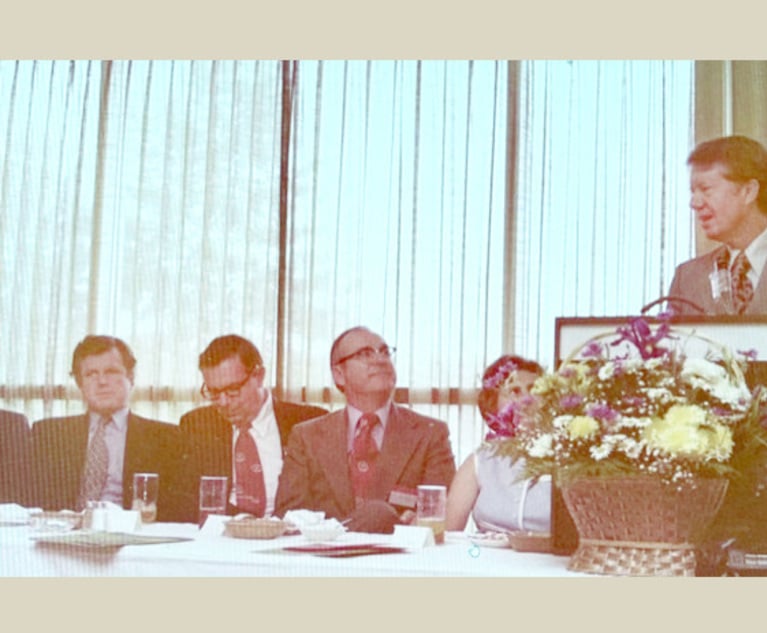Will Chief Justice Roberts Take His Own Advice When It Comes to LGBTQ Employees?
Congress may be able to clean up the law, but it can't fix the damage to the U.S. Supreme Court if it bows to political pressure to scapegoat transgender people.
October 30, 2018 at 01:06 PM
5 minute read
 U.S. Supreme Court Chief Justice John Roberts Jr./Photo: Diego M. Radzinschi/ALM
U.S. Supreme Court Chief Justice John Roberts Jr./Photo: Diego M. Radzinschi/ALM
The implications of the Trump administration's leaked plan to erase transgender people from federal law came into sharp focus last week, when the Justice Department told the U.S. Supreme Court that employers should be free to fire workers because they are lesbian, gay, bisexual, or transgender.
The filing came in the case of Aimee Stephens. Stephens was fired from her position as a funeral director when she informed her employer that she is transgender and would be coming to work consistent with her female gender. Although she agreed to continue to follow the company's conservative dress code as a woman, the company rejected the plan and put Stephens out of work. The owner of the business testified later that he was “just old-fashioned” and believed that “a male should look like … a man, and a woman should look like a woman.”
That sounds like a straightforward case of sex discrimination. And it was—at least until the Trump administration got involved.
After Stephens lost her job in 2013, the Equal Employment Opportunity Commission stepped in to sue her former company for sex discrimination—and won. Earlier this year, a federal appeals court in Cincinnati agreed that firing Stephens because she is transgender—that is, because she didn't conform to her boss' notion of what a woman should look like—was unlawful.
Meanwhile, in 2017, Attorney General Jeff Sessions issued a memorandum to Justice Department lawyers not to enforce Title VII, the federal law barring sex discrimination in employment, on behalf of transgender workers. That was a dramatic about-face for the department, which since 2014 had recognized correctly that discrimination like the kind Stephens experienced is a form of sex discrimination. Not surprisingly, the memorandum offered no new authority warranting the change in position. Nor could it, given the tremendous progress transgender people have made in securing legal recognition by the federal courts. It was little more than a naked ideological attack on transgender workers.
But the memorandum wasn't binding on lawyers for the EEOC, the independent federal agency that was pursuing Stephens' case. That changed when the funeral home asked the Supreme Court to take the case, because the Justice Department represents the EEOC before the high court.
When the Justice Department weighed in last week, it threw Stephens under the bus in furtherance of Trump's political agenda. It argued that her victory in the court of appeals—which the bipartisan EEOC had asked for—was wrong, and that firing Stephens wasn't actually “discrimination” because she could have followed the dress code (and presumably kept her job) if only she would dress as a man. In other words, if only she weren't transgender.
Despite its lengthy explanation of why the court below got it wrong, the Justice Department grudgingly conceded that the Supreme Court shouldn't review Stephens' case. Instead, it suggested, the court should take a different pair of cases involving gay workers who lost their jobs because of their sexual orientation and rule against them. That would pave the way for a similar defeat for transgender workers in a future case.
For a model of how to interpret Title VII, the high court should look not to the Justice Department's retrograde political agenda, but to its own recent history. When the court last considered whether a particular form of discrimination qualified as discrimination because of sex, in 1998, it ruled in favor of the employee—unanimously. The wronged worker had worked on an offshore oil rig, where his co-workers subjected him to sex-related humiliation and assaults, even threatening him with rape. But because all of the employees involved were men, a lower court threw the case out, reasoning that the harassment wasn't based on sex.
The Supreme Court disagreed. Justice Antonin Scalia, not known for his liberal attitude toward employees, conceded that Congress probably had not been concerned with male-on-male sexual harassment when it passed the law in 1964. But, he reasoned, the words Congress chose to use—discrimination “because of sex”—extended to the situation at hand.
The same reasoning applies to Stephens' case. It would be inconsistent with the 1998 decision—and wrong—to exclude transgender workers from a law that protects everyone from discrimination based on sex. Yet that's exactly what Stephens' former employer, represented by an anti-LGBTQ organization and now backed by the Justice Department, hopes to accomplish.
If the funeral home succeeds and the Supreme Court strips LGBTQ people of sex discrimination protections that have been recognized by a growing number of courts, the immediate blow would be to LGBTQ people. But the permanent damage would be to the court itself.
Most people in this country agree that no one should lose their job because of who they are. Those people will not be silent if the court gets it wrong. They will make their voices heard, just as they did when the court wrongly barred Lilly Ledbetter from bringing her claim of pay discrimination. They will call on Congress to pass the Equality Act, which would provide express protection against discrimination because of gender identity and sexual orientation.
Congress may be able to clean up the law, but it can't fix the damage to the court if it bows to political pressure to scapegoat transgender people. In the wake of the contentious hearings to confirm Justice Brett Kavanaugh, Chief Justice John Roberts chided his colleagues on the court to rise above partisanship. Now Aimee Stephens waits to see whether he will take his own advice.
Ria Tabacco Mar is a senior staff attorney with the ACLU's Lesbian, Gay, Bisexual, Transgender and HIV Project.
This content has been archived. It is available through our partners, LexisNexis® and Bloomberg Law.
To view this content, please continue to their sites.
Not a Lexis Subscriber?
Subscribe Now
Not a Bloomberg Law Subscriber?
Subscribe Now
NOT FOR REPRINT
© 2025 ALM Global, LLC, All Rights Reserved. Request academic re-use from www.copyright.com. All other uses, submit a request to [email protected]. For more information visit Asset & Logo Licensing.
You Might Like
View All
Switching Positions: US Solicitors General and Climate Change Lawsuits
6 minute read
Jimmy Carter’s 1974 Law Day Speech: A Call for Lawyers to Do the Public Good
14 minute readTrending Stories
- 1'It's Not Going to Be Pretty': PayPal, Capital One Face Novel Class Actions Over 'Poaching' Commissions Owed Influencers
- 211th Circuit Rejects Trump's Emergency Request as DOJ Prepares to Release Special Counsel's Final Report
- 3Supreme Court Takes Up Challenge to ACA Task Force
- 4'Tragedy of Unspeakable Proportions:' Could Edison, DWP, Face Lawsuits Over LA Wildfires?
- 5Meta Pulls Plug on DEI Programs
Who Got The Work
Michael G. Bongiorno, Andrew Scott Dulberg and Elizabeth E. Driscoll from Wilmer Cutler Pickering Hale and Dorr have stepped in to represent Symbotic Inc., an A.I.-enabled technology platform that focuses on increasing supply chain efficiency, and other defendants in a pending shareholder derivative lawsuit. The case, filed Oct. 2 in Massachusetts District Court by the Brown Law Firm on behalf of Stephen Austen, accuses certain officers and directors of misleading investors in regard to Symbotic's potential for margin growth by failing to disclose that the company was not equipped to timely deploy its systems or manage expenses through project delays. The case, assigned to U.S. District Judge Nathaniel M. Gorton, is 1:24-cv-12522, Austen v. Cohen et al.
Who Got The Work
Edmund Polubinski and Marie Killmond of Davis Polk & Wardwell have entered appearances for data platform software development company MongoDB and other defendants in a pending shareholder derivative lawsuit. The action, filed Oct. 7 in New York Southern District Court by the Brown Law Firm, accuses the company's directors and/or officers of falsely expressing confidence in the company’s restructuring of its sales incentive plan and downplaying the severity of decreases in its upfront commitments. The case is 1:24-cv-07594, Roy v. Ittycheria et al.
Who Got The Work
Amy O. Bruchs and Kurt F. Ellison of Michael Best & Friedrich have entered appearances for Epic Systems Corp. in a pending employment discrimination lawsuit. The suit was filed Sept. 7 in Wisconsin Western District Court by Levine Eisberner LLC and Siri & Glimstad on behalf of a project manager who claims that he was wrongfully terminated after applying for a religious exemption to the defendant's COVID-19 vaccine mandate. The case, assigned to U.S. Magistrate Judge Anita Marie Boor, is 3:24-cv-00630, Secker, Nathan v. Epic Systems Corporation.
Who Got The Work
David X. Sullivan, Thomas J. Finn and Gregory A. Hall from McCarter & English have entered appearances for Sunrun Installation Services in a pending civil rights lawsuit. The complaint was filed Sept. 4 in Connecticut District Court by attorney Robert M. Berke on behalf of former employee George Edward Steins, who was arrested and charged with employing an unregistered home improvement salesperson. The complaint alleges that had Sunrun informed the Connecticut Department of Consumer Protection that the plaintiff's employment had ended in 2017 and that he no longer held Sunrun's home improvement contractor license, he would not have been hit with charges, which were dismissed in May 2024. The case, assigned to U.S. District Judge Jeffrey A. Meyer, is 3:24-cv-01423, Steins v. Sunrun, Inc. et al.
Who Got The Work
Greenberg Traurig shareholder Joshua L. Raskin has entered an appearance for boohoo.com UK Ltd. in a pending patent infringement lawsuit. The suit, filed Sept. 3 in Texas Eastern District Court by Rozier Hardt McDonough on behalf of Alto Dynamics, asserts five patents related to an online shopping platform. The case, assigned to U.S. District Judge Rodney Gilstrap, is 2:24-cv-00719, Alto Dynamics, LLC v. boohoo.com UK Limited.
Featured Firms
Law Offices of Gary Martin Hays & Associates, P.C.
(470) 294-1674
Law Offices of Mark E. Salomone
(857) 444-6468
Smith & Hassler
(713) 739-1250












